Our view at Stack - Pipedrive is a robust CRM platform, offering automation, contact data collection, webhooks, AI-powered sales assistant, email communications, email marketing, and customisable sales pipeline workflows.
Even the most captivating email marketing content can fall flat if it reaches your audience at the wrong times.
Finding the perfect email cadence is a crucial ingredient of email marketing success. It’s essential for engaging buyers, forging long-term connections and closing more deals.
In this article, you’ll learn what email cadence is, why it matters and how to find the right cadence for your next marketing campaign.
What is email cadence?
Email cadence refers to the frequency and timing of marketing emails you send to prospects and customers.
For example, imagine you email your US-based newsletter subscribers at the start of every week. The cadence is one per week (frequency) at 2:00 PM EST on Mondays (timing), which you could also present in a list or template like the one below.
-
Day 1 (Monday, 2:00 PM EST): Weekly newsletter 1
-
Day 8 (Monday, 2:00 PM EST): Weekly newsletter 2
-
Day 15 (Monday, 2:00 PM EST): Weekly newsletter 3
-
Day 22 (Monday, 2:00 PM EST): Weekly newsletter 4
The right email cadence maximizes engagement, maintains interest and avoids audience fatigue. It also improves open and click-through rates, making campaigns more effective.
Email cadence vs. email frequency: what’s the difference?
Email cadence covers timing and sequence. Email frequency is how often a marketer or sales rep sends emails.
In other words, email frequency only determines the number of emails subscribers get in a given period. It doesn’t involve when they arrive.
|
Email cadence |
Email frequency |
| The frequency and timing of marketing emails | The number of marketing emails subscribers receive in a given period |
Another related term is sales cadence, which describes the planned sequence and timing of all interactions between a salesperson and prospect, not just emails. It includes phone calls, social media contact, meetings and sales demos.
A more detailed email cadence example
We used a simple newsletter as a basic email cadence example earlier but cadence also applies to more complex email campaigns.
Let’s say an e-commerce company wants to promote a new product by sending five emails to all existing customers on its US email list.
Inspired by engagement levels in previous email marketing campaigns (e.g., open rates are highest on weekday mornings, avoiding Fridays), it settles on the following email cadence.
-
Day 1 (Tuesday, 10:00 AM PT): Send a promotional email announcing the new product to all existing customers on the subscriber list.
-
Day 3 (Thursday, 10:00 AM PT): Follow up with a reminder email highlighting the key features and benefits of the new product.
-
Day 7 (Monday, 10:00 AM PT): Send a customer testimonial email showcasing how the new product has benefited existing customers.
-
Day 10 (Thursday, 10:00 AM PT): Send a limited-time offer email with a discount code for the new product.
-
Day 14 (Monday, 10:00 AM PT): Send a final reminder email about the limited-time offer before it expires.
An email cadence like this ensures the audience gets relevant product information at appropriate intervals, maximizing engagement and increasing the likelihood of conversions.
Note: A Databox survey of email marketers at 75 companies found that emails sent on Tuesday get the most engagement, followed by Monday, Wednesday and Thursday. Engagement drops significantly between Friday and Sunday.
Why does email cadence matter?
Email marketing is about getting your brand and product messages to resonate with potential customers.
Unless you consider cadence part of your email marketing strategy, you risk reaching out to prospects too often, not enough or when they’re unlikely to see or want to read your messages.
Smart Insights data shows that timing and frequency affect engagement, with open rates typically peaking early in the morning and early-mid evening before tailing off late at night.
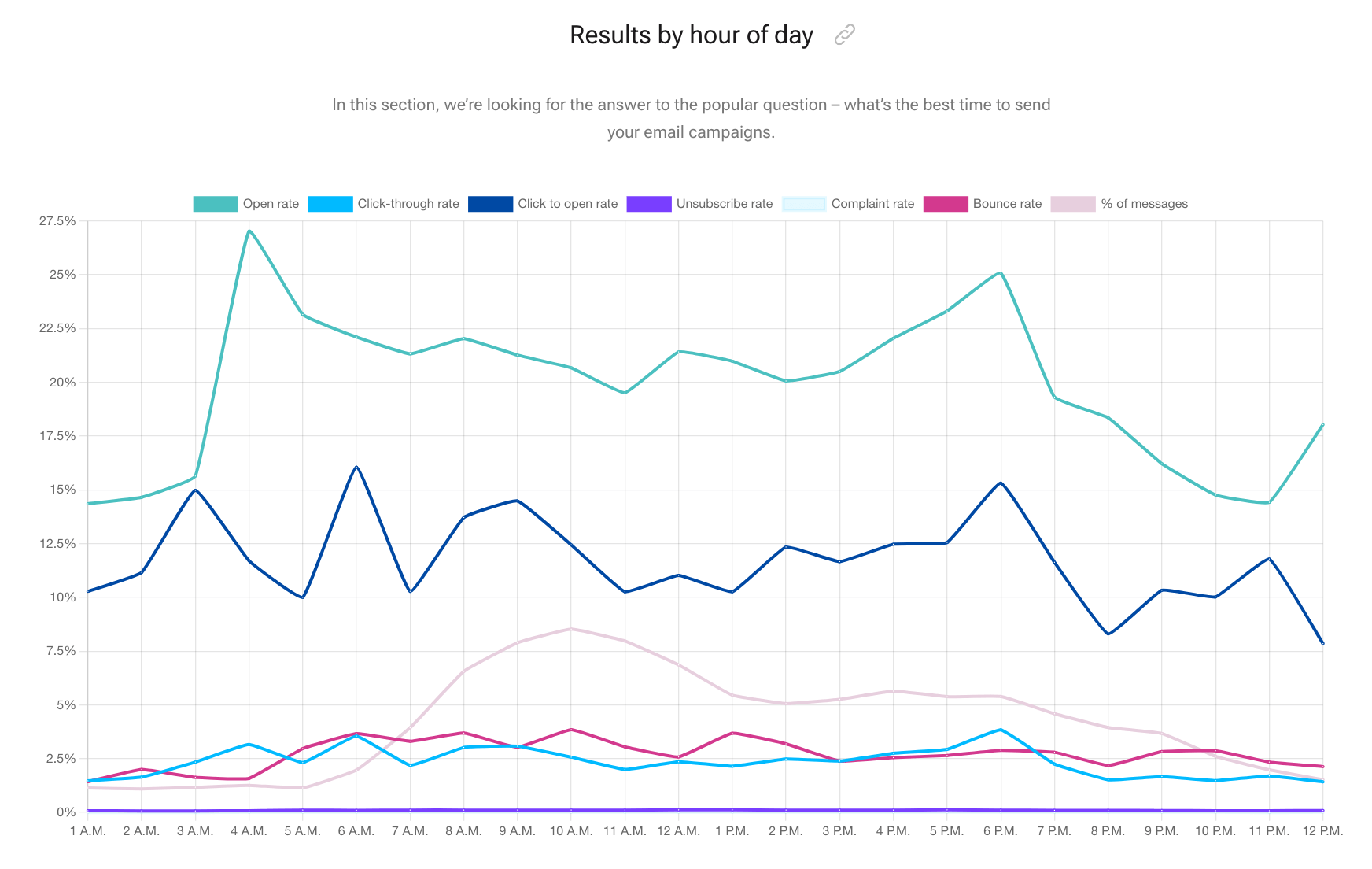
Email cadence impacts more than just open rates. Choosing your cadence carefully helps you optimize these key email marketing metrics, too:
-
Click-through rates. The more people who see and read your email content, the more traffic you’ll get to your website – as long as you include internal links and enticing calls to action.
-
Unsubscribe rates. Not overwhelming subscribers with too much content and just providing helpful information when needed means you’ll keep people interested in your brand for longer.
-
Conversion rates. When you provide valuable information at the perfect moments in the buyer journey, prospects are more likely to convert, allowing your sales team to close more deals.
Ultimately, finding the right cadence for each campaign improves your email marketing ROI and makes your business more profitable.
Free ebook: How to build a great email list
Click the button to receive 18 tips on ramping up your email list building
7 email cadence best practices: how to strike the perfect balance
Finding the correct email cadence almost always involves some trial and error. The more campaigns you run, the greater your understanding of what each subscriber segment expects and responds to will be.
Some techniques and tactics still benefit all marketers as they experiment with email cadence. Here are seven email cadence best practices to help you hit your marketing goals sooner.
1. Choose clear objectives
Start by determining what you want to achieve from your email marketing campaign, as different objectives suit different cadences.
For example, if your goal is to build authority in your industry, a regular newsletter packed with valuable updates and thought-leadership content is ideal.
Consistency helps newsletters become a familiar part of recipients’ weeks, so sending weekly emails at the same times on the same days is a logical cadence to encourage prospects through your sales funnel.
If you aim to build hype and drive website traffic around an imminent product launch, sending daily emails over a much shorter period (i.e., less than a week) may help you close deals. For a higher sending frequency like this, vary the types of content you send to keep your list engaged.
2. Segment your audience
Segmenting your audience allows you to apply different cadences to the same email campaign to increase effectiveness.
Segmenting means breaking your email list into smaller groups based on factors like demographics, behaviors and location.
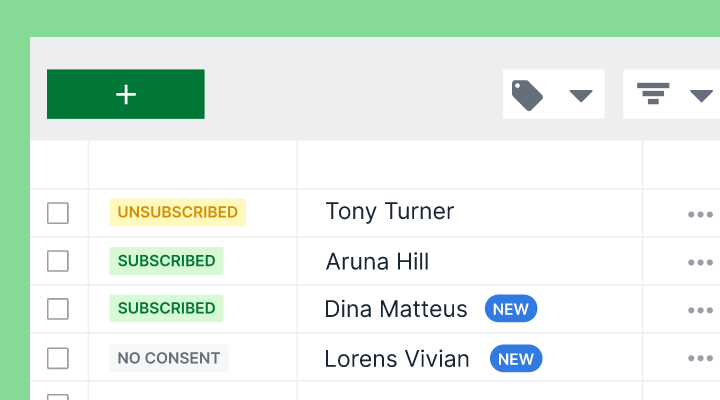
There’s little reason to vary the frequency of your emails across two similar audience segments (because you’ll likely still want to get the same message across), but you can tweak the timing to suit people in different time zones.
Alternatively, if your target is an international audience, you could segment your customers by location and adjust the sequence to avoid one location’s public holiday (when engagement could be lower).
3. Put content quality and engagement first
Frequency and timing become irrelevant if your email subject lines and content don’t interest your audience enough to entice opens and clicks, which is why email personalization and content quality are precursors to finding a successful cadence.
If people won’t open or read your messages, regardless of when you send them, one or both of the following will happen:
The simplest and most effective way to make email content more engaging is to personalize it. Make recipients feel like your messages are for them so they’re more likely to open and value your efforts. You can then confidently work on the cadence.
Here are a few ways to personalize your emails:
Personalization is another reason to segment your audience with an email marketing tool. The right software will make sending relevant content to the right people much easier and faster, maximizing engagement. Manually achieving the same level of personalization can eat up hours every week.
4. Experiment with different content formats
The types of emails you send subscribers will also influence whether a cadence works.
For example, if you send three similar plain text emails every week to the same subscriber group, recipients may get bored and start ignoring some messages. Worse still, they could unsubscribe or report your content as spam, damaging your email deliverability.
Gartner found that “repetitive and redundant” emails are the second biggest driver of unsubscriptions after “too many emails”.
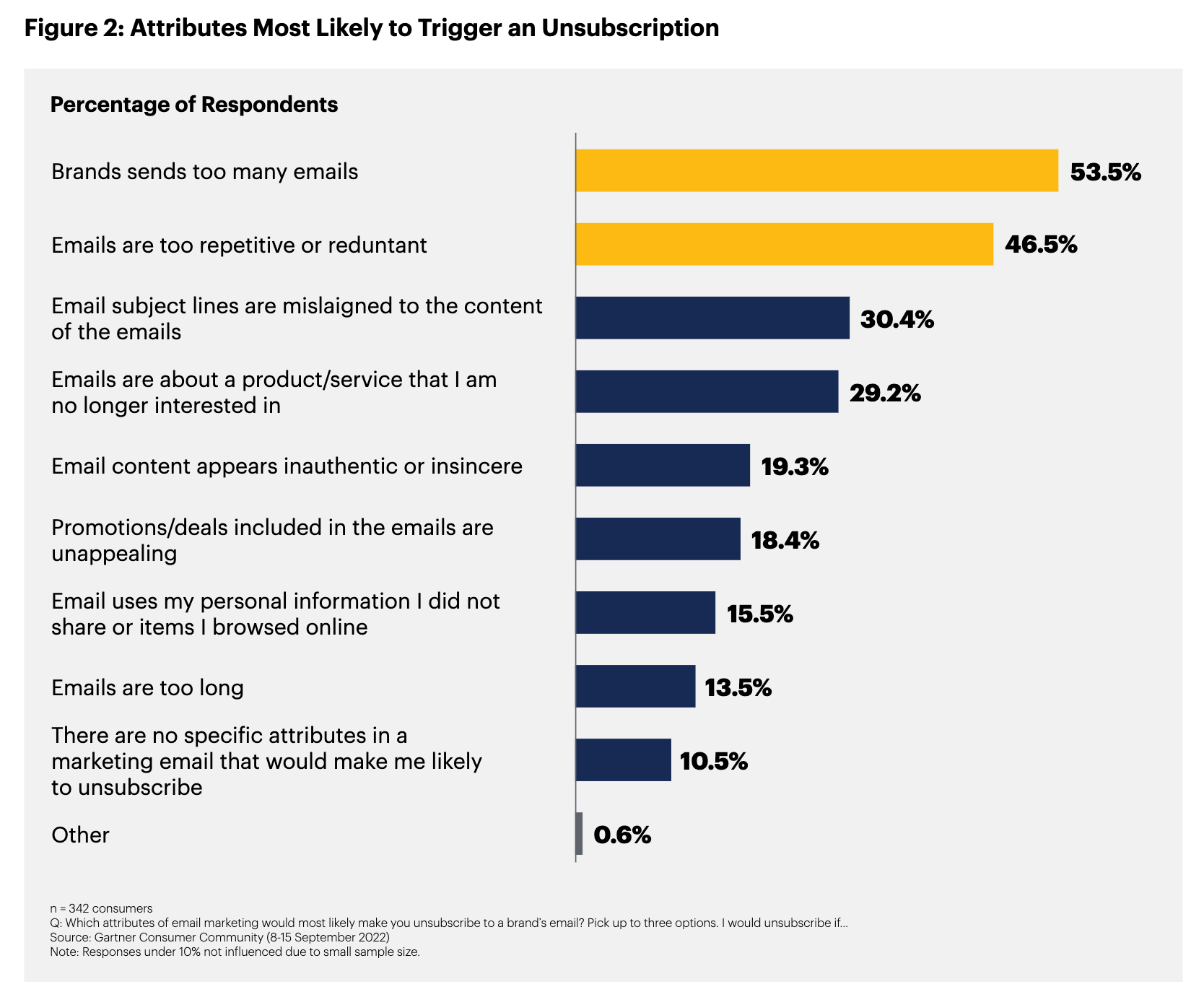
Alternatively, you could use the same cadence but vary your content formats to include:
Your audience will likely stay engaged for longer with a variety of content hitting their inboxes. It also allows you to keep a higher cadence (i.e., staying at the front of buyers’ minds) without losing subscribers or interest.
Like cadence, choosing the right content types involves trial and error. Experiment with a few of the following formats to see which delivers the best results:
-
Welcome emails
-
Testimonials and user reviews
-
How-to guides and tutorials
-
Case studies and customer stories
-
Seasonal sales promotions
-
Event invitations and reminders
-
Event and transaction follow-up emails
-
Company and product updates
-
Curated industry news roundups
-
Behind-the-scenes content
5. A/B test a range of cadences
A/B testing (or split testing) involves comparing two versions of something to see which performs better, like two different email cadences. It’s a definitive way to determine which timings, frequencies and content formats maximize engagement and minimize unsubscribes.
Note: When split testing cadences, focus on comparing your experiment results to your own baseline and performance rather than going by standard industry guides. Your strategy will be unique to your goals and audience.
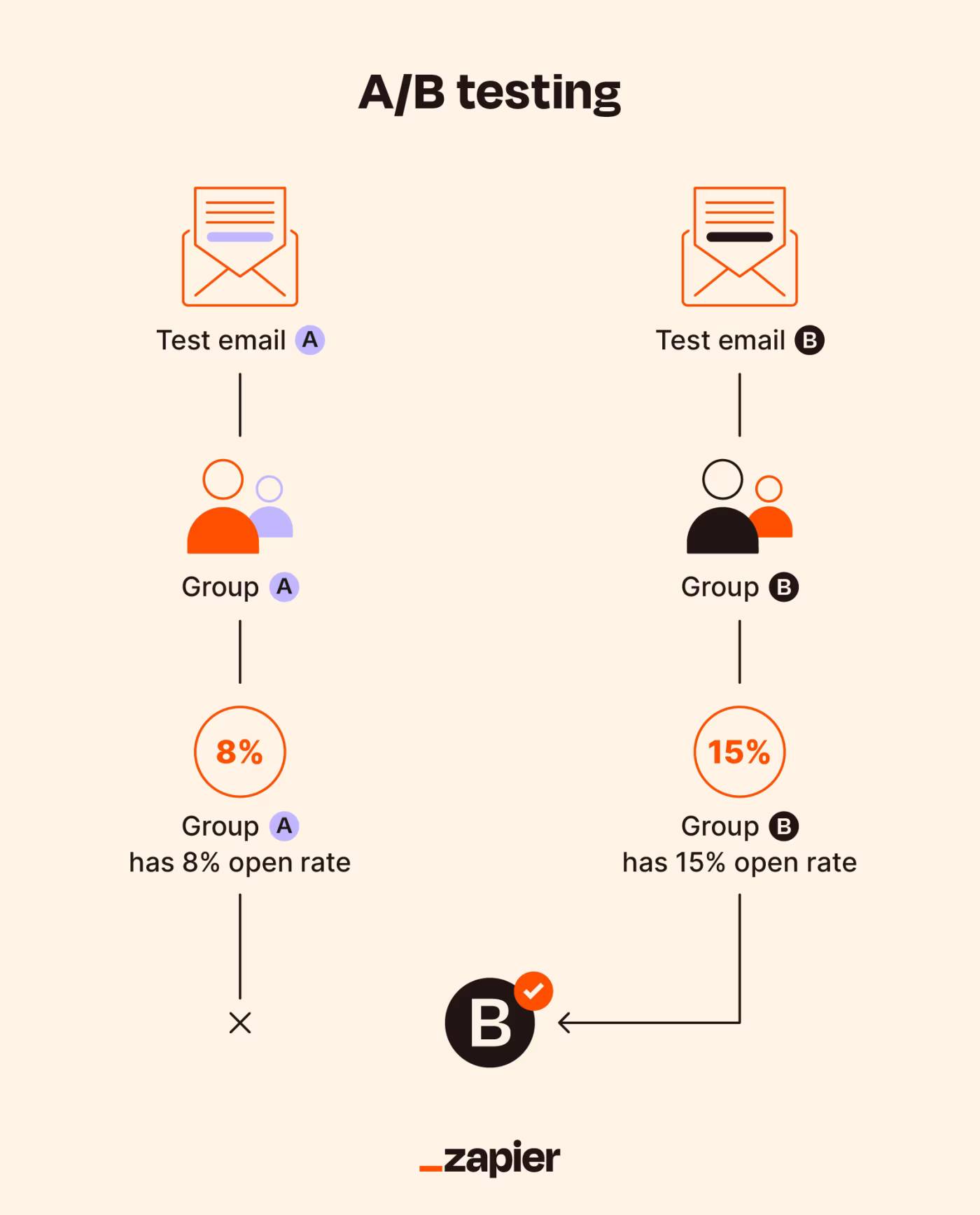
A/B testing takes some careful configuration at first but you can use specialist email marketing tools to help.
Here’s a basic A/B testing process to get you up and running:
-
Identify the test variable. Decide what aspect of your email cadence to test (e.g., weekly versus bi-weekly).
-
Create variations. Develop two versions of your email campaign, differing only in the email cadence (e.g., weekly and bi-weekly).
-
Segment your audience. Divide your email list into two random but equal segments.
-
Send the emails. Send version A (weekly) to one segment and version B (bi-weekly) to the other.
-
Monitor and analyze. Track open, click-through and unsubscribe rates for each segment.
-
Choose the winner. Identify the cadence that performed better based on your predefined metrics.
-
Implement changes. Adjust your email cadence according to the results of the A/B test, and continue to optimize over time.
The more A/B tests you run, the better you’ll understand what your audience wants from your marketing campaigns and when they want it. Speed up the process by building a library of trusted email templates for testing.
6. Let subscribers choose email frequency (and unsubscribe)
Giving subscribers control over their email cadence can stop them from opting out of your mailing list if they enjoy your content but feel they receive too many emails.
Let’s say most of your audience is happy to receive two emails per week but some feel that’s too often.
Without a frequency setting, their only options are to:
-
Keep receiving too many messages and ignoring or deleting those they don’t want to read
-
Unsubscribe and end their relationship with your brand (44% of respondents to a Zero Bounce survey cited receiving too many messages as the main reason they unsubscribe from email lists)
However, adding a third option – to switch to weekly emails – encourages people to stay subscribed (and connected to your brand) on their terms.
It involves adding a link at the bottom of every message with text reading something like “manage my email preferences”, like in the example from a Livestorm webinar invite below. Direct this to a page where subscribers can change settings regarding what they receive and how often.
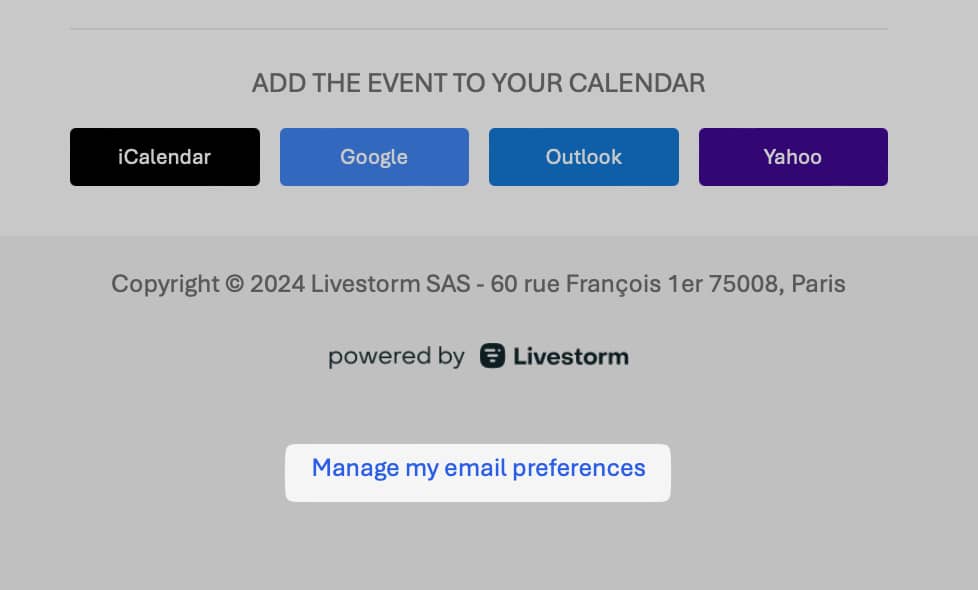
Some email marketing and email cadence software can automate the process of letting subscribers change their frequency settings.
Even if yours doesn’t, give recipients a form to express their opinions. You can then change their settings manually and gauge consensus across your email list.
7. Invest in intuitive email marketing tools for support
The best email marketing software can remove the stress from running campaigns so you can focus on finer details like finding the right frequency and timing.
For example, here are four ways Pipedrive’s Campaigns add-on helps users find the perfect email cadences:
-
Campaign automation. Eliminate campaign admin to spend more time tweaking and testing email cadences.
-
Drag-and-drop email builder. Create a library of email templates to test cadences faster.
-
Email segmentation. Split audiences and tailor email cadence to each group based on engagement levels, preferences and behaviors.
-
Email marketing analytics. Track open, click-through and unsubscribe rates to see when email cadence changes affect engagement.
An email marketing tool that connects to your customer relationship management (CRM) software lets you unify sales and marketing data. You can source prospects’ information when building campaigns and effortlessly funnel your most engaged subscribers into your sales pipeline.
For example, you could use your CRM to spot patterns between email cadence and sentiment. If you increase your cadence of after-sales emails and CRM data suggests new customers are becoming happier, you’ll know they value the extra information you provide. If sentiment suffers, it’s time to revisit your cadence.
Email Cadence FAQs
Final thoughts
Cadence is up there with content quality as one of the most critical factors in your email marketing success.
There’s no one-size-fits-all approach to email cadence. However, continual testing and tweaking will help you learn what your audience responds to. As a result, you can build winning campaigns faster and more consistently.
Follow the email cadence best practices in this guide and keep refining your strategy to improve your email marketing results this year and beyond.
Start planning your email marketing campaign now
Click the button to receive a free email marketing campaign planner ebook
If Pipedrive is of interest and you'd like more information, please do make contact or take a look in more detail here.
Credit: Original article published here.
